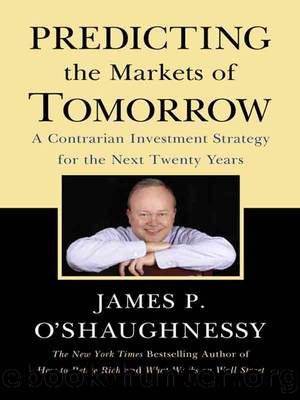Predicting the Markets of Tomorrow by James P. O'Shaughnessy

Author:James P. O'Shaughnessy
Language: eng
Format: epub
Publisher: Penguin Group US
Published: 2006-11-15T00:00:00+00:00
Representativeness
We often assume things will come out the way we think they shouldâstocks with great performance should have great stories driving their gains. Great companies should be great investments; boring companies should be boring investments. In forming subjective judgments people look for familiar patterns, relying on well-worn stereotypes. These mental shortcuts are called heuristics, or mental rules of thumb. In many instances, these mental shortcuts are helpful, but not when it comes to investing. Here, they frequently lead to errors in judgment. Weâve seen, for example, that people largely ignore how frequently something occurs. These odds are called base rates. Base rates are among the most illuminating statistics that exist. Theyâre just like batting averages. For example, if a town of 100,000 people had 70,000 lawyers and 30,000 librarians, the base rate for lawyers in that town is 70 percent. When used in the stock market, base rates tell you what to expect from a certain class of stocks (e.g., all stocks with high dividend yields) and what that variable generally predicts for the future. But base rates tell you nothing about how each individual member of that class will behave.
Most statistical prediction techniques use base rates. Seventy-five percent of university students with grade point averages above 3.5 go on to do well in graduate school. Smokers are twice as likely to get cancer. Stocks with low price-to-earnings ratios outperform the market 65 percent of the time. The best way to predict the future is to bet with the base rate that is derived from a large sample. Yet numerous studies have found that people make full use of base rate information only when there is a lack of descriptive data. In one example, people are told that out of a sample of 100 people, 70 are lawyers and 30 are engineers. When provided with no additional information and asked to guess the occupation of a randomly selected 10, people use the base rate information, saying all 10 are lawyers, since by doing so they assure themselves of getting the most right.
However, when worthless but descriptive data is added, such as âDick is a highly motivated thirty-year-old married man who is well liked by his colleagues,â people largely ignore the base rate information in favor of their âfeelâ for the person. They are certain that their unique insights will help them make a better forecast, even when the additional information is meaningless. We prefer descriptive data to impersonal statistics because it better represents our individual experience. When stereotypical information is added, such as âDick is thirty years old, married, shows no interest in politics or social issues and likes to spend free time on his many hobbies which include carpentry and mathematical puzzles,â people totally ignore the base rate and bet Dick is an engineer, despite the 70 percent chance that he is a lawyer. One can even jack the base rate for lawyers up to over 90 percent, and people will cling to their stereotypical opinion of an engineer.
Download
This site does not store any files on its server. We only index and link to content provided by other sites. Please contact the content providers to delete copyright contents if any and email us, we'll remove relevant links or contents immediately.
Rich Dad Poor Dad by Robert T. Kiyosaki(6185)
Pioneering Portfolio Management by David F. Swensen(6083)
How To Win Friends and Influence People by Dale Carnegie(4340)
The Money Culture by Michael Lewis(3851)
The Dhandho Investor by Mohnish Pabrai(3564)
The Wisdom of Finance by Mihir Desai(3529)
Liar's Poker by Michael Lewis(3228)
The Intelligent Investor by Benjamin Graham Jason Zweig(2936)
The ONE Thing by Gary Keller(2922)
Mastering Bitcoin: Programming the Open Blockchain by Andreas M. Antonopoulos(2895)
Fooled by Randomness: The Hidden Role of Chance in Life and in the Markets by Nassim Nicholas Taleb(2866)
Rich Dad Poor Dad: What The Rich Teach Their Kids About Money - That The Poor And Middle Class Do Not! by Robert T. Kiyosaki(2836)
How to Win Friends and Influence People by Dale Carnegie(2799)
Investing For Dummies by Eric Tyson(2798)
How to Day Trade for a Living: Tools, Tactics, Money Management, Discipline and Trading Psychology by Andrew Aziz(2787)
Market Wizards by Jack D. Schwager(2545)
Zero Hour by Harry S. Dent Jr. & Andrew Pancholi(2536)
How to Pay Zero Taxes, 2018 by Jeff A. Schnepper(2503)
Rich Dad's Guide to Investing by Robert T. Kiyosaki(2412)
